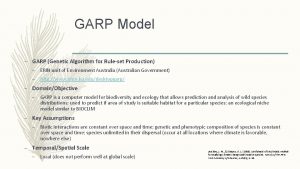GARP Model GARP Genetic Algorithm for Ruleset Production



- Slides: 3

GARP Model – GARP (Genetic Algorithm for Rule-set Production) – ERIN unit of Environment Australia (Australian Government) – http: //www. nhm. ku. edu/desktopgarp/ – Domain/Objective – GARP is a computer model for biodiversity and ecology that allows prediction and analysis of wild species distributions; used to predict if area of study is suitable habitat for a particular species; an ecological niche model similar to BIOCLIM – Key Assumptions – Biotic interactions are constant over space and time; genetic and phenotypic composition of species is constant over space and time; species unlimited in their dispersal (occur at all locations where climate is favorable, nowhere else) – Temporal/Spatial Scale – Local (does not perform well at global scale) Jeschke, J. M. , & Strayer, D. L. (2008). Usefulness of bioclimatic models for studying climate change and invasive species. Annals of the New York Academy of Sciences, 1134(1), 1‐ 24.

Input Drivers • Known species distribution (GIS) • Environmental parameters thought to limit the species (elevation, aspect, slope, daily average temperature, precipitation, soil, etc. ) Key Outputs • Predicted species distribution (GIS) Peterson, A. T. (2003). Predicting the geography of species’ invasions via ecological niche modeling. The quarterly review of biology, 78(4), 419‐ 433.

Examples of Results Drake, J. M. , & Bossenbroek, J. M. (2004). The potential distribution of zebra mussels in the United States. Bio. Science, 54(10), 931‐ 941. Stockman, A. K. , Beamer, D. A. , & Bond, J. E. (2006). An evaluation of a GARP model as an approach to predicting the spatial distribution of non‐vagile invertebrate species. Diversity and Distributions, 12(1), 81‐ 89.





